Joy Neal Kidney's Blog, page 21
April 17, 2024
The Horse Lawyer and Other Poems by Greg Seeley
 The Horse Lawyer and Other Poems chronicles the struggles and triumphs of three generations of an Iowa farm family over a 125-year period. The “story” begins with a soldier coming home from the Civil War and setting foot for the first time on his newly-purchased farm and ends when the land next changes hands in the early 1990s. The book is the story of the family, their friends, and their neighbors as they try to adapt to the changing world around them. Their lives and personal aspirations are shaped by two world wars, a harsh climate, the dust bowl, and the Great Depression. They seek to meet this adversity and thrive through love, self-reliance, work, faith, and a strong sense of community.
The Horse Lawyer and Other Poems chronicles the struggles and triumphs of three generations of an Iowa farm family over a 125-year period. The “story” begins with a soldier coming home from the Civil War and setting foot for the first time on his newly-purchased farm and ends when the land next changes hands in the early 1990s. The book is the story of the family, their friends, and their neighbors as they try to adapt to the changing world around them. Their lives and personal aspirations are shaped by two world wars, a harsh climate, the dust bowl, and the Great Depression. They seek to meet this adversity and thrive through love, self-reliance, work, faith, and a strong sense of community.
A Couple of Reviews
Amaria, on Amazon: There is history here defined with heritage expressing hardworking times, the value of simpler times and cherishing those times, those things we today take for granted, the love of land and family despite hardship, building a home, growing crops. These poems read like letters intimate, invaluable and heartfelt. They spoke of comfort of home, life and family ties. They held longing and sacrifice, peace and resilience of a life once lived and a legacy carried on. There is also authenticity, honesty and a rawness and tranquility to these poems. Very well written work!My thoughts: These are delightful and accessible vignettes. What a compelling way to preserve and share the soul of three generations of farm families, through the author’s fatherline in free verse. Not only that, but they lived on the same nook of Iowa soil over a span of 125 years. I’m encouraged to try something similar with my own motherline.
The Horse Lawyer and Other Poems is divided into the three generations and accompanied by winsome photos. I especially enjoyed the poems called “His Rocker,” “Fraternity of the Soil,” and the two about aging–“Two Shall Be As One” and “It’s Getting Gray.”
Greg Seeley
 Greg Seeley was raised on a farm north of Afton, Iowa. He graduated from the University of Northern Iowa with a major in history and received his Master’s Degree from the University of Iowa. Greg is a retired certified public accountant and lives in Overland Park, Kansas with his wife Carolyn, a retired math teacher.
Greg Seeley was raised on a farm north of Afton, Iowa. He graduated from the University of Northern Iowa with a major in history and received his Master’s Degree from the University of Iowa. Greg is a retired certified public accountant and lives in Overland Park, Kansas with his wife Carolyn, a retired math teacher.
Greg Seeley also wrote Tractor Bones and Rusted Trucks: Tales and Recollections of a Heartland Baby Boomer, which is a collection of poetry and short stories. He also written two Civil War stories.
April 16, 2024
Bonnie and Clyde Robbed the Stuart Bank on this Date, 1934
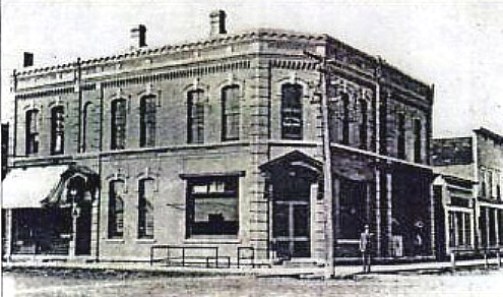 Nine months after their shootout in Dexfield Park, Bonnie and Clyde returned to the area and robbed the Stuart bank, just five miles to the west of Dexter, Iowa.
Nine months after their shootout in Dexfield Park, Bonnie and Clyde returned to the area and robbed the Stuart bank, just five miles to the west of Dexter, Iowa.
 Photo by Jon Morgan
Photo by Jon MorganFrom the Stuart website: “On April 16, 1934, the First National Bank in Stuart fell victim to infamous outlaws Bonnie Parker and Clyde Barrow. The bank lost about $1,500 (approximately $30,000 today). Bonnie & Clyde were chased out of Stuart by a local posse and killed in a police ambush in Louisiana approximately one month later. Although there were fortunately no fatalities in the Stuart robbery, the Barrow gang is believed to have murdered at least nine police officers and four civilians during their crime sprees. First National Bank in Stuart ceased operations in 1944, and the building now houses a hair salon. It is located at the intersection of North 2nd Street and Division Street in the heart of downtown Stuart. Historical markers have been erected at this popular tourist attraction.”
Today, an upstairs apartment of the bank building is being converted into an Airbnb, called the Bonnie & Clyde Hideout.
—–
There was an attempt to rob that same bank during the night of March 29/30, 1921, resulting in no money lost but the death of the Stuart night watchman, John Kerr Meyers.
My grandfather, Clabe Wilson, became part of Stuart’s history when he became their next nightwatchman. Here is the story of the robbery attempt, the loss of Mr. Meyers, and the new man the town hired.
April 15, 2024
Kin Types by Luanne Castle
 Eric Hoffer Award Finalist Kin Types is a collection of lyric poetry, prose poetry, and flash prose that imaginatively retells the lives of private individuals from previous generations. Using family history research, the writer has reconstructed the stories of women and men from Michigan to Illinois to the Netherlands. Read together, the pieces create a history of women dealing with infant mortality, vanity, housewife skills, divorce, secret abortion, the artist versus mother dilemma, mysterious death, wife beating, and a brave heroine saving a family’s home.
Eric Hoffer Award Finalist Kin Types is a collection of lyric poetry, prose poetry, and flash prose that imaginatively retells the lives of private individuals from previous generations. Using family history research, the writer has reconstructed the stories of women and men from Michigan to Illinois to the Netherlands. Read together, the pieces create a history of women dealing with infant mortality, vanity, housewife skills, divorce, secret abortion, the artist versus mother dilemma, mysterious death, wife beating, and a brave heroine saving a family’s home.
A Couple of Reviews
Partial Amazon review by Jen Payne: It is no surprise that for the three nights since reading KIN TYPES, I have had vivid dreams of my own family. It is no surprise because Luanne Castle’s thought-full book presents the concept of family in such a palpable manner, one feels as if you have sat across the table from an aunt, a grandmother, a cousin, and heard family stories that could very well be your own.
Layered with poems and prose, you turn a page to reveal the next colorful character, the faded memory, the texture of a detail only a poet would think to include. The result is a beautiful collage of the family experience — its loves and losses, its joys and sorrows, its tragedies and secrets.
My thoughts: The stories of ancestors help keep them alive. Luanne Castle does that regularly on her blog called “The Family Kalamazoo,” but in this slim volume of 19 poems and flash prose, she captures individuals with a vignette of well-chosen details that give you goosebumps, even a lump in your throat. They are poignant, sharing some harsh scenes as well as how one name is so ubiquitous in her ancestry.
I especially enjoyed the one about family resemblances in old photographs, and noting the names, dates, and places as her forebears crossed the ocean from The Netherlands and Germany and settled in Michigan. I also enjoyed finding pictures of some of these on her genealogy blog.
This delightful chapbook helps keep alive individuals largely forgotten otherwise. A creative way to approach genealogy, which is why I keep returning to this one!
Luanne Castle
 Luanne Castle lives in Arizona, next to a wash that wildlife use as a thoroughfare. She has published two full-length poetry collections, Rooted and Winged (Finishing Line Press 2022), a Book Excellence Award Winner, and Doll God (Kelsay Books 2015), which won the New Mexico-Arizona Book Award for Poetry. Her chapbooks are Our Wolves (Alien Buddha Press 2023) and Kin Types (Finishing Line Press 2017), a finalist for the Eric Hoffer Award. Luanne’s Pushcart and Best of the Net-nominated poetry and prose have appeared in Copper Nickel, American Journal of Poetry, Pleiades, River Teeth, TAB, Verse Daily, Saranac Review, and other journals. Luanne blogs at Writer Site and The Family Kalamazoo.
Luanne Castle lives in Arizona, next to a wash that wildlife use as a thoroughfare. She has published two full-length poetry collections, Rooted and Winged (Finishing Line Press 2022), a Book Excellence Award Winner, and Doll God (Kelsay Books 2015), which won the New Mexico-Arizona Book Award for Poetry. Her chapbooks are Our Wolves (Alien Buddha Press 2023) and Kin Types (Finishing Line Press 2017), a finalist for the Eric Hoffer Award. Luanne’s Pushcart and Best of the Net-nominated poetry and prose have appeared in Copper Nickel, American Journal of Poetry, Pleiades, River Teeth, TAB, Verse Daily, Saranac Review, and other journals. Luanne blogs at Writer Site and The Family Kalamazoo.
Please check out Luanne’s website.
April 13, 2024
Dust and Diamonds: Poems of Faith and Beyond by Donn Taylor

Poems of Earth and Beyond
A collection of well-crafted poems addressing fundamental questions of human experience in today’s world — its sadnesses and triumphs, and the humor that tempers them both.
A Couple of ReviewsLinda Yezak: Beautiful collection containing tongue-in-cheek humor and heartbreakingly beautiful messages of love. There are only two modern poets who capture my heart and mind with every line, and Donn is one of them.My thoughts: These poems in Dust and Diamond are wide-ranging, from profound to tongue-in-cheek, all delightful. I especially enjoyed the beautiful “Notation,” the gritty “Panhandle Dust Storm,” “Epigram: 1869,” the miracle of “Ear,” the profound “Terminal Conditions,” and the laugh-out-loud “Fashion Models.”
Donn Taylor
 Donn Taylor led an Infantry rifle platoon in the Korean War, served with Army aviation in Vietnam, and worked with air reconnaissance in Europe and Asia. Afterwards, he completed a PhD at The University of Texas and taught English literature at two liberal arts colleges. Now retired from college teaching, he writes suspense and mystery fiction as well as literary poetry designed for the ordinary reader. He lives in the woods near Houston, TX, where he continues to write fiction, poetry, and essays on ethics and U.S. foreign policy.
Donn Taylor led an Infantry rifle platoon in the Korean War, served with Army aviation in Vietnam, and worked with air reconnaissance in Europe and Asia. Afterwards, he completed a PhD at The University of Texas and taught English literature at two liberal arts colleges. Now retired from college teaching, he writes suspense and mystery fiction as well as literary poetry designed for the ordinary reader. He lives in the woods near Houston, TX, where he continues to write fiction, poetry, and essays on ethics and U.S. foreign policy.
You might want to visit Donn’s website.
April 12, 2024
Grief Songs: Poems of Love & Remembrance by Elizabeth Gauffreau
 When a loved one dies, the family will often turn to the photograph albums as an act of solace, to keep their loved one with them just a little while longer. Grief Songs: Poems of Love & Remembrance arose from that experience. The collection opens with three free verse expressions of raw grief, followed by a series of photographs from the author’s family album, each paired with a poem written in tanka. Taken together, they tell the story of a loving family lost.
When a loved one dies, the family will often turn to the photograph albums as an act of solace, to keep their loved one with them just a little while longer. Grief Songs: Poems of Love & Remembrance arose from that experience. The collection opens with three free verse expressions of raw grief, followed by a series of photographs from the author’s family album, each paired with a poem written in tanka. Taken together, they tell the story of a loving family lost.
JJ Casey: Grief Songs by Elizabeth Gauffreau is a wonderful collection of short poems and poignant, old family photographs. Altogether, a heartfelt and personal tribute to love, life, laughter and the difficulties in-between. This short book is a strong testament to Liz’s acumen as a writer and poet—the most difficult to write well are the short poems, where word choice and structure become so important, and Grief Songs is replete with prime examples. My favorite is ‘At The Cottage’:
“pensive eyes downcast / salt-laden breeze, bird racket / second pregnancy / birds devour chokecherries / before long spoiling the lawn”
So much to unpack in so few words—bravo, Liz.
My thoughts: My emersion into the poems in Grief Songs, along with those winsome photos, was a bittersweet journey through grief over profound losses but also deeply layered family love. Those saddleshoes, that pipe, a dress with smocking–what endearing details. Tears welled up when I resavored the one called “Time.” A very compelling collection.Elizabeth Gauffreau Elizabeth Gauffreau writes fiction and poetry with a strong connection to family and place. She holds a BA in English/Writing from Old Dominion University and an MA in English/Fiction Writing from the University of New Hampshire. . . .
Elizabeth Gauffreau writes fiction and poetry with a strong connection to family and place. She holds a BA in English/Writing from Old Dominion University and an MA in English/Fiction Writing from the University of New Hampshire. . . .
Liz grew up a child of the 1960s in northern New England before spending twenty years in the South as a Navy wife. After working for Granite State College in Concord, New Hampshire for eighteen years, she accepted a faculty position as Assistant Dean of Curriculum and Assessment at Champlain College Online in Burlington, Vermont. In addition to academic advising, teaching, and higher education administration, her professional background includes assessment of prior experiential learning for college credit. Liz lives in Nottingham, New Hampshire with her husband; their daughter has flown the nest to live in sunny California.
You may want to learn more about Liz Gauffreau on her website.
April 11, 2024
My Memories of WHO Radio’s 100 Years
 My lifelong go-to radio station turned 100 years old this week, first aired on April 10, 1924.
My lifelong go-to radio station turned 100 years old this week, first aired on April 10, 1924.
Ronald “Dutch” Reagan was the first sports director for WHO.
On December 7, 1941, mother heard the announcement about the attack on Pearl Harbor over WHO. Family members regularly tuned in for news about the war.
Herb Plambeck’s nasal voice is the first I remember from WHO Radio, from the 1950s and probably before. Dad always listened to the farm show at noon, which was Plambeck’s expertise. Plambeck was also the host of the 1948 National Plowing Match north of Dexter, highlighted with a major address by President Harry Truman. WHO was a sponsor of the plowing match.
We were there, among the estimated throng of 100,000 sweltering folks gathered in the field that day. Dad perched me on his shoulders so I could catch a glimpse of the man on the platform. I barely remember it.
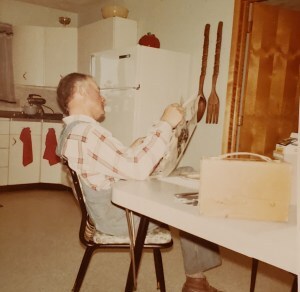 Dad listening to the markets on the noon news on his favorite radio, and checking the newspaper. 1970s
Dad listening to the markets on the noon news on his favorite radio, and checking the newspaper. 1970sWhen sis Gloria and I were grade schoolers, we listened to Jack Shelley when it snowed hard, hoping for a “snow day” from school. WHO voices from my childhood include Ev Hickman and Jim Zabel. Other favorite personalities from the past: Keith Kirkpatrick, Lee Kline, Mark Pearson, Captain Jack, Jan Michaelson, Van and Patti, Van and Connie, Van and Bonnie (yes, three co-hosts over the years).
The station includes news, sports, talk radio, entertainment, a farm show, plus national broadcasts. But the main draw for me is its local personalities: Jeff Angelo, Simon Conway, Dave Bohl, newswoman Sue Danielson, even two who run the boards–photographer Margaret Kisper and Drake student JD Snover.
During the most recent decade, I’ve enjoyed listing to Our American Stories With Lee Habeeb over WHO-Radio and recording a dozen or so stories for them.
 First radio interview, with Maxwell Schaeffer, 2019 (shortly before my shoulder replacement)
First radio interview, with Maxwell Schaeffer, 2019 (shortly before my shoulder replacement)As the Leora books have been published, WHO Radio hosts have been gracious to interview me about each one: Maxwell Schaeffer on the Saturday show, Van Harden, Emery Songer, Max & Amy in the Morning, and, most recently, Simon Conway!
Here’s a terrific overview of the radio station by Iowa History Journal publisher, Michael Swanger, in the March/April issue.
You might enjoy this slim history of the station, Iowa’s WHO Radio: The Voice of the Middle West by Jeff Stein.
April 10, 2024
Variety is the Spice of Life: A blend of poetry and prose by Sally Cronin
 Variety is the Spice of Life is a collection of poetry and short stories about relationships with others, including pets and animals inhabiting the world around us. The connection with others brings love and friendship, excitement and sometimes surprises, danger, mystery and sometimes the unexpected.
Variety is the Spice of Life is a collection of poetry and short stories about relationships with others, including pets and animals inhabiting the world around us. The connection with others brings love and friendship, excitement and sometimes surprises, danger, mystery and sometimes the unexpected.
The poetry explores human nature, the fears, desires, expectations and achievements. Nature offers a wonderful opportunity to observe animals both domesticated and wild. Even in a back garden you can observe a wide variety of creatures and the daily challenges to survive a harsh environment.
The short stories introduces you to a healer whose gift comes with danger, a neighbour determined to protect a friend, a woman on the run, an old couple whose love has endured, an elderly retired teacher who faces a life changing accident, a secret that has been carried for over 70 years and a village who must unite as they face devastating news.
Reviews of Variety is the Spice of Life
A partial one by Claire Fullerton (you may find the entire review on Amazon): I have long been a fan of Sally Cronin’s writing, so it was with great enthusiasm that I read her November 2022 release, Variety is the Spice of Life, whose title is delightfully appropriate for the assembly of poetry and prose that covers a range of topics.
In Ms. Cronin’s author introduction, she states the essence of her book’s intention, “In this latest collection of poetry and short stories I have attempted to capture the beauty and raw power of nature, and the resilience of humans as they face a modern world of change and disruption.” The author does that and more, and the entirety of this book is a breath of fresh air replete with creative nuance.
My thoughts: Sally lives in Ireland. Her poems, including winsome ones about nature, are so delightful. In the US, starlings are considered pests, but Sally’s poems about the glossy birds and their dance of murmuration are winsome. The short stories are especially compelling, including one about the outbreak of WWII. An admirable variety of originality. The cover of the book is perfect for the array of creativity readers will find inside.
The Author
 Sally Cronin is the author of sixteen books including her memoir Size Matters: Especially when you weigh 330lb first published in 2001. This has been followed by another fifteen books both fiction and non-fiction including multi-genre collections of short stories and poetry.
Sally Cronin is the author of sixteen books including her memoir Size Matters: Especially when you weigh 330lb first published in 2001. This has been followed by another fifteen books both fiction and non-fiction including multi-genre collections of short stories and poetry.
As an author she understands how important it is to have support in marketing books and offers a number of FREE promotional opportunities on her blog and across her social media. The Smorgasbord Bookshelf
Sally has been so generous to share others’ books and blogposts, including the Leora stories, through her own.
Her podcast shares book reviews, poetry and short stories. Sally Cronin Soundcloud
After leading a nomadic existence exploring the world, she now lives with her husband in Ireland Ireland enjoying the seasonal fluctuations in the temperature of the rain.
Please check out Sally’s Amazon Author Page. She has written several wonderful books!
Ever So Gently: A Collection of Poems by Lauren Scott

In Ever So Gently, Lauren Scott shares her strong link to nature, taking the reader on a tranquil walk through a redwood grove. You’ll find an invitation to sit quietly on a patio, captivated by the simple beauty of a hummingbird. She’ll entice you to revel on the shore of a freshwater lake, mesmerized by its stunning beauty.
Scott shares how love has shaped her life. From that first delicious kiss to celebrating decades of marriage through a love that deepens over time. How her heart melted when she became a mom, then ached when her children started their adult lives across country. And how her adorable canine companions found their way into her heart.
Scott underscores how life presents mysteries we struggle to solve. We can’t help but ponder the deeper meaning of a simple vision. She prompts you to reminisce and reflect on your past, present, and future. Through the ups and downs. what matters most is to love and live ever so gently.
A Couple of Reviews
D. L. Flynn: “Ever So Gently” is a beautiful collection of free verse and symbolic poetry. It is broken into three sections that cover nature, life’s moments, and some author insights. I love nature and I’m drawn to vivid images, but the emotions and insights explored in our shared experiences were equally intriguing. There was a peace within these pages that allowed me to drift off into a poetic slumber when I was done reading. Although I enjoyed the entire collection, here are a few lines that captured my heart. “Fresh raindrops/gently landed/on their wilted spirit/as I witnessed them lifting…”—Wilted Spirits, “You stowed dreams in the clouds,/imaginings rose higher than the heavens…”—First Breath, “Their presence graced my universe beautifully like an endless ceiling of bright blue sky. Then they were gone.”—Friendships Gone, and “Its glow will grow ever so gently/into a bright beacon of hope/rising with the golden sun/bringing clarity to our vision.”—Ever So Gently. A collection that I will be enjoying again and can highly recommend.
My thoughts: Ever So Gently is Lauren’s latest book of poetry. What an endearing gathering of short poems, some written as Haiku and other syllabic poetry, but all comforting, calming, restorative. Presented in three sections, these verses pose the wonder of nature, the love of family, even the delight of a pet. An elegant medley.
Lauren Scott

Lauren Scott is a poet and writer of short stories, both fiction and reflections of her life. She enjoys small-town living in Northern California with her husband, Matthew, and their lab, Copper; they have two grown children. She has authored two collections of poetry: New Day, New Dreams (2013) and Finding a Balance (2015). In 2021, she released her memoir, More than Coffee, and her latest book is a poetry collection, Ever So Gently, that was released in July 2023.
Please find out more about Lauren’s other books of poems on her BaydreamerWrites website.
April 9, 2024
There was a Time: poems, musing, and thoughts of experiencing cancer – by Andrew Reynolds
In his blog post yesterday, As The Pizza Cooks–Episode 24, Andrew Reynolds confessed, “A year or two after I finished my cancer treatments, I thought I’d write a book about the experience, but when I sat down to write that, it all came out as poetry. I blame the radiation — must have changed something in my brain.”
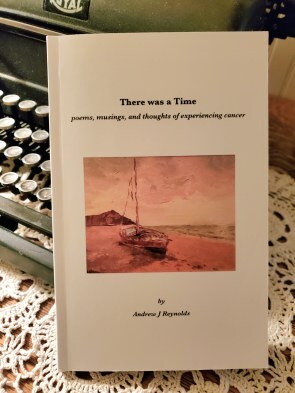 This compelling book is a poetic and emotional response to being treated for prostate cancer, which takes the reader on a poignant journey through the emotions of diagnosis, treatment and recovery. There was a Time also looks at the loss of his mother to pancreatic cancer, and the difficulty of watching a loved one pass from this world to the next.
This compelling book is a poetic and emotional response to being treated for prostate cancer, which takes the reader on a poignant journey through the emotions of diagnosis, treatment and recovery. There was a Time also looks at the loss of his mother to pancreatic cancer, and the difficulty of watching a loved one pass from this world to the next.
You’d think the topics would be off-putting, but Andrew handles them so deftly.
Another partial review from Carrie on Amazon:
“I opened up this book with the intention of reading a few poems from it each day, which, as someone who doesn’t read much poetry, is often how I approach it, but once I started, I couldn’t stop. In this collection of poems, Reynolds chronicles the maelstrom of thoughts and emotions that accompany a diagnosis of cancer, its treatment and recovery, and its psychological toll. Part of my eagerness to devour these poems was my background as a physician–it’s always thought-provoking to read about a patient’s experiences–but most of it stemmed from the beauty and rawness of the author’s words. . . .”
 Andrew Reynolds is a poet, writer, blogger, woodworker, and computer engineer who holds a BA in English from San Jose State University. Andrew Reynolds retired from the high-tech world of Silicon Valley and has moved to Reno, NV where he lives with his wife and three cats.
Andrew Reynolds is a poet, writer, blogger, woodworker, and computer engineer who holds a BA in English from San Jose State University. Andrew Reynolds retired from the high-tech world of Silicon Valley and has moved to Reno, NV where he lives with his wife and three cats.
There was a Time is not available through Amazon, but if you’re interested in it, contact Andrew here.
Andrew’s View of the Week is eclectic, with everything from his hobbies with his scroll saw and quilting, ponderings, and his list of groaners every Friday. I’ve been watching for more of Andrew’s poems. I says maybe early next year!
April 8, 2024
Granger Homestead by Brent Hegstrom
Granger Homestead a success of New Deal policy, Fr. Ligutti vision
In the small town of Granger [Iowa], coal mining was the number one industry in the area in the 1930 but because it was seasonal work, it caused problems with the men working the mines. Their work most times slacked off in April and did not pick up again until sometime in September.
As a result, their cash was usually too low to have a decent standard of living. Most of the workers lived near the mines in homes that were owned by the mine operators, and the rent was taken from the miners’ pay.
These house were poorly built and small in size, producing overcrowded and unsanitary neighborhoods. Most of the miners were in poor heath, and they had few if any cultural and educational facilities.
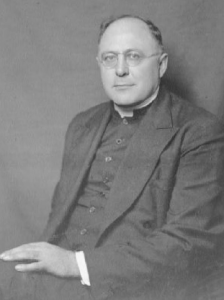 Photo from findagrave
Photo from findagraveThe Division of Subsistence Homesteads was set up by the U.S. Department of the Interior in 1933 to help low-income workers to attain a healthy and dignified quality of life. Father Luigi Gino Ligutti of the Catholic parochial school started a drive to get a division project placed near Granger.
The Homestead Division approved the project in March 1934, acquiring 224 areas of land just west of town. Granger Homestead was started to provide 50 miners with modern homes at low cost to them. In February 1935 they signed a contact with Lovejoy Co. of Des Moines for the building of 50 homes.
The plan was for four-, five- and six-room houses, and the construction was completes by December 1935. Each house had two stories and a full basement. Inside walls were plywood, and the ceilings were celotex.
Mechanical equipment included modern plumbing, closets, hot air furnaces and hot water heaters. Each home had its own well with an electric pump and a septic system.
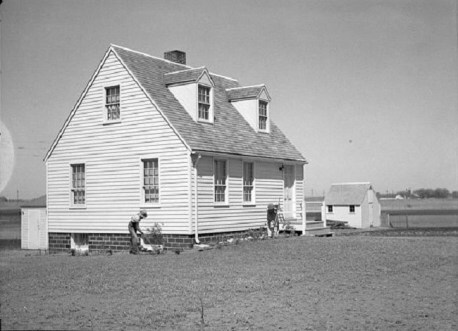 Photo from Brent Hegstrom’s article
Photo from Brent Hegstrom’s articleThe cost of each home was about $2,232 and the total cost, including outbuilding, land, utilities and house was about $4,097. The units rented for $13.96 to $18.59 a month.
One lot was set aside for a community building, a place for meetings, working space, canning and more. Children attended the Granger Public School or the Assumption Catholic School in Granger. The library was run by the women’s club of the project.
Some homesteaders spoke little English and were not able to take part in all community events. An unusual custom deriving from the European background of some of the homesteaders was the practice of using the basement for living and not the first floor.
All homes had well-finished basements, with tiled walls and cement floors. A large number of the mining families moved their kitchen stove to the basement, along with floor lamps, tables, radios and other furniture, and the basement became their kitchen, dining room and living room.
After World War II, the homestead had its biggest change. In 1946 the Dallas Mine closed down, putting the miners out of work, but they had struck roots and stayed in Granger. Some found work in the Shuler Mine at Waukee, but most found work in Des Moines, Perry and Ames.
By 1946 the Association owed the government just $24,594.62. In January 1951, the Granger Homestead families celebrated a mortgage burning at the Assumption school. Only eight members had not paid off their homes in full, and they arranged for a private loan.
By 1951 32 of the original 50 families were left. In the history of the homestead, no one had defaulted on their loan.
Today, the Granger Homestead is filled with new homes, and many of the original ones have additions. West of town, the Beaver Catholic Cemetery is filled with the names of families whose lives were changed thanks to this successful federal housing program — where Biondi, Battani, Callan, Comer and so many others are neighbors in death as they were in life.
Fr. Ligutti died in 1988 and just as he predicted, he is buried here as well. “At Rest Among the People He Loved” is graven on his marker.
By Brent Hegstrom, published Nov. 16, 2019, The Perry News—–The First Lady, Eleanor Roosevelt, traveled to Iowa to visit the Granger Homestead on June 10, 1936. About the day from her diary.Division of Subsistence HomesteadsHistorical Marker


